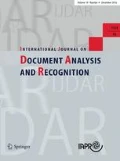Abstract
This paper describes a robust context integration model for on-line handwritten Japanese text recognition. Based on string class probability approximation, the proposed method evaluates the likelihood of candidate segmentation–recognition paths by combining the scores of character recognition, unary and binary geometric features, as well as linguistic context. The path evaluation criterion can flexibly combine the scores of various contexts and is insensitive to the variability in path length, and so, the optimal segmentation path with its string class can be effectively found by Viterbi search. Moreover, the model parameters are estimated by the genetic algorithm so as to optimize the holistic string recognition performance. In experiments on horizontal text lines extracted from the TUAT Kondate database, the proposed method achieves the segmentation rate of 0.9934 that corresponds to a f-measure and the character recognition rate of 92.80%.
Similar content being viewed by others
References
Tseng L.Y., Chen R.C.: Segmenting handwritten Chinese characters based on heuristic merging of stroke bounding boxes and dynamic programming. Pattern Recognit. Lett. 19(10), 963–973 (1998)
Zhao S., Chi Z., Shi P., Yan H.: Two-stage segmentation of unconstrained handwritten Chinese characters. Pattern Recognit. 36(1), 145–156 (2003)
Liang Z., Shi P.: A metasynthetic approach for segmenting handwritten Chinese character strings. Pattern Recognit. Lett. 26(10), 1498–1511 (2005)
Furukawa, N., Tokuno, J., Ikeda, H.: Online character segmentation method for unconstrained handwriting strings using off-stroke features. In: Proceedings of the 10th International Workshop on Frontiers in Handwriting Recognition, pp. 361–366. La Baule, France (2006)
Liu C.-L., Sako H., Fujisawa H.: Effects of classifier structures and training regimes on integrated segmentation and recognition of handwritten numeral strings. IEEE Trans. Pattern Anal. Mach. Intell. 26(11), 1395–1407 (2004)
Cheriet M., Kharma N., Liu C.-L., Suen C.Y.: Character Recognition Systems: A Guide for Students and Practitioners. Wiley, New York (2007)
Su T.-H., Zhang T.-W., Guan D.-J., Huang H.-J.: Off-line recognition of realistic Chinese handwriting using segmentation-free strategy. Pattern Recognit. 42(1), 167–182 (2008)
Murase, H.: Online recognition of free-format Japanese handwritings. In: Proceedings of the 9th International Conference on Pattern Recognition, vol. 2, pp. 1143–1147. Rome, Italy (1988)
Fukushima, T., Nakagawa, M.: On-line writing-box-free recognition of handwritten Japanese text considering character size variations. In: Proceedings of the 15th International Conference on Pattern Recognition, vol. 2, pp. 359–363. Barcelona, Spain (2000)
Senda, S., Yamada, K.: A maximum-likelihood approach to segmentation-based recognition of unconstrained handwriting text. In: Proceedings of the 6th International Conference on Document Analysis and Recognition, pp. 184–188. Seattle, WA (2001)
Nakagawa M., Zhu B., Onuma M.: A model of on-line handwritten Japanese text recognition free from line direction and writing format constraints. IEICE Trans. Inf. Syst. E 88(D(8), 1815–1822 (2005)
Ding, X., Liu, H.: Segmentation-driven offline handwritten Chinese and Arabic script recognition. In: Proceedings of the Summit on Arabic and Chinese Handwriting, pp. 61–73. College Park, USA (2006)
Zhu, B., Nakagawa, M.: On-line handwritten Japanese text recognition by improving segmentation quality. In: Proceedings of the 11th International Conference on Frontiers in Handwriting Recognition, pp. 379–384. Montréal, Canada (2008)
Tulyakov, S., Govindaraju, V.: Probabilistic model for segmentation based word recognition with lexicon. In: Proceedings of the 6th International Conference on Document Analysis and Recognition, pp. 164–167. Seattle, WA (2001)
Zhou, X.-D., Yu, J.-L., Liu, C.-L., Nagasaki, T., Marukawa, K.: Online handwritten Japanese character string recognition incorporating geometric context, In: Proceedings of the 9th International Conference on Document Analysis and Recognition, pp. 48–52. Curitiba, Brazil (2007)
Chen M.Y., Kundu A., Srihari S.N.: Variable duration hidden Markov model and morphological segmentation for handwritten word recognition. IEEE Trans. Image Process. 4(12), 1675–1687 (1995)
Yu, J.-L., Zhou, X.-D., Liu, C.-L.: Search strategies in online handwritten character string recognition (in Chinese). In: Proceedings of the 1st Chinese Conference on Pattern Recognition, pp. 299–305. Beijing, China (2007)
Zhu B., Nakagawa M.: Segmentation of on-line freely written Japanese text using SVM for improving text recognition. IEICE Trans. Inf. Syst. E E91(D1), 105–113 (2008)
Mori, H., Aso, H.: Postprocessing for Japanese document recognition based and 2nd order Markov model (in Japanese). Technical report of IPS J, NL-94-63, pp. 89–96. (1994)
Platt J.: Probabilistic outputs for support vector machines and comparisons to regularized likelihood methods. In: Smola, A.J., Bartlett, P., Scholkopf, D., Schuurmanns, D. (eds) Advances in Large Margin Classifiers, MIT Press, Cambridge (1999)
Oda, H., Zhu, B., Tokuno, J., Onuma, M., Kitadai, A., Nakagawa, M.: A compact on-line and off-line combined recognizer. In: Proceedings of the 10th International Workshop on Frontiers in Handwriting Recognition, pp. 133–138. La Baule, France (2006)
Nakagawa M., Matsumoto K.: Collection of on-line handwritten Japanese character pattern databases and their analysis. Int. J. Document Anal. Recognit. 7(1), 69–81 (2004)
Juang B.-H., Katagiri S.: Discriminative learning for minimum error classification. IEEE Trans. Signal Process. 40(12), 3043–3054 (1992)
Robbins H., Monro S.: A stochastic approximation method. Ann. Math. Stat. 22, 400–407 (1951)
Author information
Authors and Affiliations
Corresponding author
Rights and permissions
About this article
Cite this article
Zhu, B., Zhou, XD., Liu, CL. et al. A robust model for on-line handwritten japanese text recognition. IJDAR 13, 121–131 (2010). https://doi.org/10.1007/s10032-009-0111-y
Received:
Revised:
Accepted:
Published:
Issue Date:
DOI: https://doi.org/10.1007/s10032-009-0111-y




